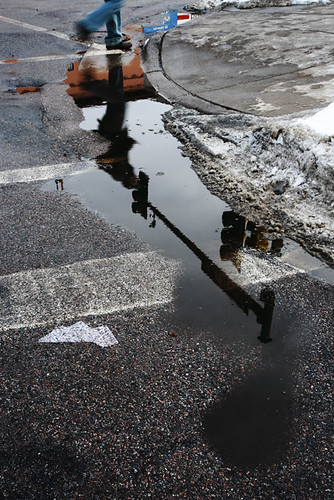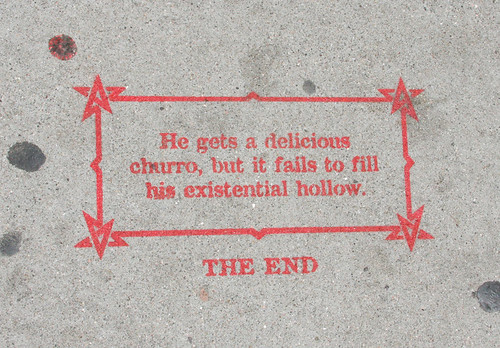 Careful! The sidewalks are treacherous this time of year. It's beautiful outside, but I actually fell on my ass this morning while walking to the bus stop on the corner. I was thinking about sidewalks, as I always do . . . thinking about the way in which melty puddles force us to walk in certain ways, wondering whether or not people who live in puddle-wonderful places require more chiropractic care, when I stepped rather quickly on a very very invisible sheet of ice that was just melting in the late morning sun.
Careful! The sidewalks are treacherous this time of year. It's beautiful outside, but I actually fell on my ass this morning while walking to the bus stop on the corner. I was thinking about sidewalks, as I always do . . . thinking about the way in which melty puddles force us to walk in certain ways, wondering whether or not people who live in puddle-wonderful places require more chiropractic care, when I stepped rather quickly on a very very invisible sheet of ice that was just melting in the late morning sun.I fell like the stock market. I bruised me knee!
Then, later that same morning, I was riding the bus over to the U of MN and we were going through the SE Como neighborhood, where all the students live. The bus was sitting on the corner, at the stop, waiting for a light to turn green. I was looking out the window at the springtime sunshine, when all of a sudden I saw a girl come out the door of the house on the corner.
She seemed so happy on this warm spring day. The sun lit up her blonde hair, her backpack was full of books, and her face lit up like a lightbulb when she saw the waiting bus and started running down the steps toward it. Her smile was worth a million dollars.
Her foot hit the sidewalk, and BAM! she went feet-over-head and almost landed on her face. It was terrible! Such a sidewalk tragedy! It was the worst thing I've seen since the 1986 World Series.
Then, to make matters worse, the bus took off in a cloud of diesel fumes, leaving her sitting there on the invisibly icy sidewalk.
Tread with care, Twin Cities!
<<<>>>
Here's another Jane Jacobs reference! It's Steven Johnson's commentary on a David Brooks NYT column who rather surprisingly mentions Jane Jacobs as a complexity thinker, a thinker of emergence and self-organization. It's an idea I've been excited by for a long time, and Steven Johnson is one of my heroes when it comes to putting together cities and complexity theory. His book Emergence, like all his books, is something you should pick up. Here's the relevant Brooks passage, in all its glory:
For people raised on Jane Jacobs, who emphasized how a spontaneous dynamic order could emerge from thousands of individual decisions, this is a persuasive way of seeing the world. For young people who have grown up on Facebook, YouTube, open-source software and an array of decentralized networks, this is a compelling theory of how change happens.
David Brooks is one of the only conservatives I can stand, and I might really enjoyed his semi-comic Bobos in Paradise if it hadn't been turned into such a durable political meme.
<<<>>>
I love this idea, also from New York, to limit how 'curb cuts', those driveways that interrupt sidewalks can be controlled.
 For example, I snapped this photo by the Seward Luce of a minivan that was parked, rather permanently, right in the middle of the sidewalk during the middle of the day.
For example, I snapped this photo by the Seward Luce of a minivan that was parked, rather permanently, right in the middle of the sidewalk during the middle of the day.As a pedestrian, I find this so obnoxious. I just want to key this Pontiac until it bleeds motor oil. But as a driver, I find it completely convenient and natural. My bank is located on Grand Avenue, and I just zip out of the ATM lane and could very easily run over like five or six children and sidewalk puppies if I wasn't paying attention.
If you ask me, drive-thru banks are a real detriment to society. Down with the pneumatic tube!
(Also, the word "thru" is a real detriment to English.)
<<<>>>
Here's the Where Blog covering some context to the diversity debate, including Jane Jacobs (again), Richard Florida, and Harvard sociologist Robert Putnam's take on diversity. The question: does living in a diverse neighborhood make you more or less tolerant? (My answer: Yes and no, of course)
<<<>>>
An MSNBC article on plants that grow in the cracks of sidewalks . . . sidewalk evolution in a whole new light. Are there entire species of sidewalk adapted organisms? For example:
C. sancta produces two types of fruit, one that is heavy and falls on the ground near its parent plant, and another that is lighter and blown to other patches of ground by the wind. The researchers compared plants that grew in small "tree boxes" along the sidewalks of Montpellier, France, to plants that grew in open areas outside of town.
My 85 year old uncle likes nothing more than pointing out which of the teensy, dirty plants that grow along medians, curbs, and sidewalks are edible, and how when he was a kid growing up in the depression those little green bits would have been an entire meal . . . a delicious salad.
<<<>>>A nice Strib piece on a bus driver who finally said enough to those giant, slushy icy mounds of crusty blackgreywhite snow-ish matter that clogs sidewalks, abuts car doors and curbs . . . and causes bench sitting havoc throughout the Minesota winterspring. Not only a story pitting human against nature, but an almost Kafka-eque tale of bureaucratic struggle . . . a must read!
Noland has tried just about everything he could think of to get more curbs cleared of snow and ice (he stopped short of jackhammering them out himself).
He sent letters to supervisors and the city. He called 311 and got work orders to have specific corners cleared. He posted notices at the bus garage under the name GlacierGuy.
<<<>>>
A previously unknown to me group advocating walking in the great city of Minneapolis . . . called Walking Minneapolis. Sensibly, founder Sarah Harris realizes that cold weather does not mean that TC'ers should stay inside. This from an interview:
Q: Isn't it too cold here to get people walking outside?
A: The experts we consulted from Copenhagen and Toronto say no. There are many good days in this town and about 20 frigid onces. Skyways perform a vital function. But in a certain ways they can limit street life. Walking Minneapolis is designed for exploration, good health, and discovery.
Damn right! I have never understood why Minnesotans are mortally terrified of winter. Put on a jacket! Why do you own that beautiful wool coat if you don't want to wear it? There are like a handful of really cold winter days, and even those can be enjoyable if you dress right.
We've spend too much time trying to build environments that keep us from enjoying winter -- skyways, Metrodomes, Malls of America -- and too little time ice fishing and walking down avenues. Remember: suffering is good for you!
<<<>>>
I need to remember how much I love the Uptown Minneapolis blog. Beautiful photos of the infrastructure all around us. Here's my recent favorite:
<<<>>>
I don't know how I'm going to write poetry about sidewalks that have poetry written on them. The very idea hurts my head . . . but its a great idea.
A while back I read about Choose Your Own Adventure sidewalks in San Francisco, that had kind of combined situationism and city-as-text into one fabulous street game.

<<<>>>
And finally, in a more sobering vein, an article from the New Yorker about the how US housing equity has gone negative (or "underwater"), and how the inflexibility of homeownership actually limits the US economy's ability to adapt to change. For example:
Homeownership also impedes the economy’s readjustment by tying people down. From a social point of view, it’s beneficial that homeownership encourages commitment to a given town or city. But, from an economic point of view, it’s good for people to be able to leave places where there’s less work and move to places where there’s more.
In a way, many Americans are actually owned by their homes, instead of the other way around. Home, not as fortress, not as castle, but as domestic prison. But really, what's the difference?
1 comment:
What entertaining answer
Post a Comment